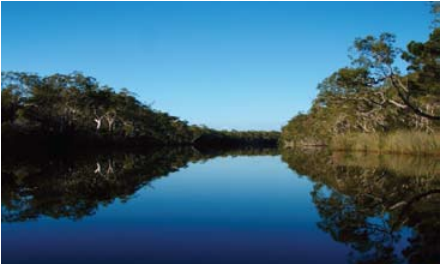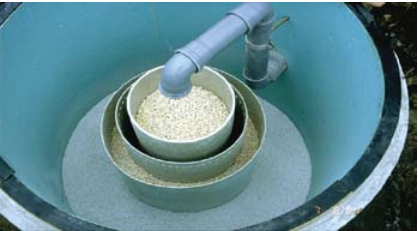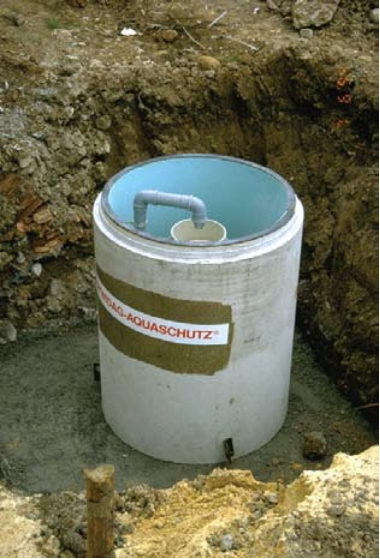CHLORTRANSORBER®
Entchlorung und Neutralisation
Task:
In times of increasingly scarce water resources water protection is the most important task. Therefore, the legislature, in order to prevent the pollution of our rivers and lakes, adopt appropriate discharge regulations for wastewater.(Water Act §7a, wastewater regulation Annex 31)
 The threshold for chlorine is fixed on: 0.2 mg / l or as cargo: 4 g / h . Chlorinated water from drinking water or swimming pool water devices that exceeds these limits, must not be introduced into the public sewage systems or in to the surface waterst.
The threshold for chlorine is fixed on: 0.2 mg / l or as cargo: 4 g / h . Chlorinated water from drinking water or swimming pool water devices that exceeds these limits, must not be introduced into the public sewage systems or in to the surface waterst. Through this regulation, the formation of undesired organic chlorine compounds in the water is to be prevented i, as they are environmental toxins (chlorinated hydrocarbons, Haloforms, AOX) . Some substances thereof,e.g. the chloroform, are suspected to have carcinogenic or mutagenic properties.
Through this regulation, the formation of undesired organic chlorine compounds in the water is to be prevented i, as they are environmental toxins (chlorinated hydrocarbons, Haloforms, AOX) . Some substances thereof,e.g. the chloroform, are suspected to have carcinogenic or mutagenic properties. Furthermore, the pH of wastewater must be in the range of 6.5. Only by this the corrosive destruction of the drainage systems and disturbance of the biological stage of wastewater treatment plants can be avoided. It should be excluded that water-polluting substances and groups endanger the environment, our water resources and ultimately our health.
Furthermore, the pH of wastewater must be in the range of 6.5. Only by this the corrosive destruction of the drainage systems and disturbance of the biological stage of wastewater treatment plants can be avoided. It should be excluded that water-polluting substances and groups endanger the environment, our water resources and ultimately our health.
 Chlorine gas accident, how often does that happen?
Chlorine gas accident, how often does that happen?
We have identified the following frequencies: From the total number of operating chlorine gas plants (> 20,000 St. in Germany), the number of by us installed equipment of the last 10 years and the documented incidents in connection with our plants the possibility is > 5% during this time. This means that statistically 120 ± 10 chlorine incidents occur each year. This number includes both smaller, more dangerous accidents, but also dangerous spills.
For security reasons all chlorine gas storage in swimming pools and drinking water plants must be equipped with a dechlorination system. This is usually a sprinkler system, which is used for deposition of the leaked chlorine gas. Eliminating chlorine gas through a sprinkler system is still the most effective and economical method that technology offers . The disadvantage is the production of chlorine and acid sprinkler water. Measurement of the chlorine content and the pH value of sprinkler water at chlorine gas accidents have shown that the threshold values are far exceeded by chlorine and that the pH-value is far too low.. Therefore sprinkler water must be dechlorinate and neutralized before it is discharged directly or may be issued in the public sewage system.
 For disinfection of swimming pool water or drinking water chloride is used. In order to achieve a sufficient disinfection effect, concentrations up to 0.3 mg / l free chlorine occur in the waters in accordance with the relevant regulations. These waters are obtained during the filter backwash and must be disposed of. According to the introduction conditions, this water must be dechlorinated and neutralized in order to initiate it directly or indirectly into the public sewage system If the wastewater is derived from a pelvic drain , no free chlorine must be detectable (completed dechlorination).
For disinfection of swimming pool water or drinking water chloride is used. In order to achieve a sufficient disinfection effect, concentrations up to 0.3 mg / l free chlorine occur in the waters in accordance with the relevant regulations. These waters are obtained during the filter backwash and must be disposed of. According to the introduction conditions, this water must be dechlorinated and neutralized in order to initiate it directly or indirectly into the public sewage system If the wastewater is derived from a pelvic drain , no free chlorine must be detectable (completed dechlorination).
 With the CHLORTRANSORBER® system it is possible to dechlorinate and neutralise chlorine rich sprinkler and bathing waters. The plant needs no warm up and is always ready for use. This feature makes the plant especially suitable for waters from sprinkler systems used to control chlorine gas leaks.
With the CHLORTRANSORBER® system it is possible to dechlorinate and neutralise chlorine rich sprinkler and bathing waters. The plant needs no warm up and is always ready for use. This feature makes the plant especially suitable for waters from sprinkler systems used to control chlorine gas leaks.
The plant is designed in such a way that water flows through separate dechlorination and neutralisation chambers and then to drain. The resulting pressure drop due to friction will be compensated through a cascade design which implies that no other energy sources are needed to operate the system.
The standard plants have a maximum pressure drop of: 0.05 bar ( 0.5m Head ) During the conception and design of the drainage system this 0.5m must be taken into account so that the CHLORTRANSORBER® plant is able to work at its maximum efficiency. The contaminated water is dechlorinated using calcium sulphite and neutralised using calcium carbonate. These minerals are non toxic, are suited for the preparation of potable water and are resistant to abrasive effects which in turn reduces the time needed for maintenance and increases the reliability of the plant. Chlorine rich water will first flow into the distribution pipe which sends the flow into the first and second dechlorination chambers. Here, all the free chlorine will react with calcium sulphite and become hydrochloric acid. The calcium sulphite will in turn be oxidised to calcium sulphate After the water has left the dechlorination chambers it enters the neutralisation chamber. The hydrochloric acid reacts with calcium carbonate and calcium hydroxide and is neutralised. The products of the reaction are calcium chloride and carbon dioxide in solution. The chemical reactions can be depicted as the following:
Reaction of gaseous chlorine and water: Cl2(g) +H2O(l) HClO(aq) + HCl(aq)
Dechlorination: HClO(aq) + CaSO3(s) CaSO4(aq) + HCl(aq)
Neutralization: 2HCl(aq) + CaCO3(s) CaCl2(aq) + H2O(l) + CO2(g) 2HCl(aq) + Ca(OH)2(s) CaCl2(aq) + 2H2O
(l) The granular calcium sulphite, carbonate and hydroxide have low solubility in water, their respective masses in the reactor depends on the type of reactor and the chlorine loading which is to be treated. If there are a sufficient reaction bed depth and a long enough contact time for the dechlorination and neutralisation minerals, full dechlorination and neutralisation is guaranteed and the filtrate will correspond to the strictest wastewater disposal regulations. The minerals used in these reactors are non toxic, easy to handle, and resistant to weather effects. These fixed bed reactors can be kept either in stand by mode in the dry state or even underwater without a deterioration of their dechlorination and neutralisation properties.
• Berliner Wasserwerke • Fernwasserversorgung Elbaue-Ostharz GmbH • Frankfurter Wasserwerke • Rostocker Wasserwerke • Südsachsen Wasser GmbH • Erzegbirgs -Trinkwasser GmbH • Wasserverband Brockwitz-Rödern-Meissen-Dresden • Stadtwerke Aalen • East Camp Grafenwöhr / US-Army • Wasserwerk Annaberg-Buchholz • Wasserwerk Bohlheim • Wasserwerk Mühlhausen • Wasserwerk Böhringen • Freibad Nidda • Freibad Bad Freienwalde • Freibad Quickborn • Freibad Querfurt • Freibad Struth-Helmershof • Freibad Ilmenau • Freibad Moosbach • Freibad Neuzelle • Freibad Mihla • Gesundheitsbad Alexandra Leutenberg • Hallenbad Geyer • Freibad Großostheim/Frankfurt • Freibad Duisburg • Freibad Schmalkalden • Freibad Mannheim • Freibad Hohne / Celle • Freibad Schleusingen